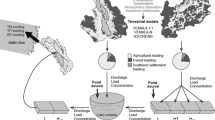Abstract
Cyanidation tailings disposed of in a surface impoundment experience a loss of cyanide due to natural attenuation, which frequently reduces the cyanide concentration to very low levels. Quantifying cyanide losses in terms of impoundment geometry, local weather conditions and feed-solution chemistry has been largely empirical in spite of the fact that, in many cases, mining operations rely on surface impoundments to reduce cyanide to below an internally regulated concentration or below an effluent limitation. To permit a quantitative evaluation of cyanide losses in an impoundment, a computer simulation was developed to estimate the losses of free, weak acid dissociable (WAD) and total cyanide due to dissociation, photolysis and volatilization. Results of the model are compared with data collected for a North American tailings impoundment in 1998.
Similar content being viewed by others
References
Broderius, S., 1973, “Determination of Molecular Hydrocyanic Acid in Water and Studies of the Chemistry and Toxicity to Fish of Metal-Cyanide Complexes,” Ph.D. Thesis, Oregon State University.
Broderius, S., and Smith, L.L., 1980, “Direct Photolysis of Hexacyanoferrate Complexes: Proposed Applications to the Aquatic Environment,” US Environmental Protection Agency Report 600/3-80-003.
Eastern Research Group, 1997, “Preferred and Alternative Methods for Estimating Air Emissions from Wastewater Collection and Treatment,” Final Report, Prepared for the Emission Inventory Improvement Program and the US Environmental Protection Agency, Vol. II, Chapter 5.
Flynn, C.M., and McGill, S.L., 1995, “Cyanide Chemistry — Precious Metals Processing and Waste Treatment,” US Bureau of Mines, NTIS Document PB96-117841.
Goldman, C.R., and Home, A.J., 1983, Limnology, McGraw-Hill, New York, Chapter 3.
Maracle, K.J., 1992, “Cyanide Regeneration of Gold Mill Barren Solutions Using Hollow Fibre Gas Membranes,” Master of Engineering Thesis, McMaster University, Ontario, Canada.
Murphy, K.L. and Robertson, J.L., 1979, “Factors Affecting Natural Degradation of Free and Metal Complexed Cyanides from Gold Milling Effluents,” A Literature Review for Fisheries & Environment Canada, Burlington, Ontario, Canada.
Sadek, S.E., Smith, J.D., Watkin, A.T., and Gebel, R., 1996, “Mass transfer of volatile organics from large open basins,” Environmental Progress, Vol. 15, No. 2, pp. 82–92.
Schmidt, J.W., Simovic, L., and Shannon, E., 1981, “Development studies for suitable technologies for the removal of cyanide and heavy metals from gold milling effluents,” Proceedings of the 36th Industrial Waste Conference, Purdue University, pp. 831–846.
Simovic, L., 1984, “Kinetics of Natural Degradation of Cyanide from Gold Mill Effluents,” Master of Engineering Thesis, McMaster University, Ontario, Canada.
Simovic, L., Snodgrass, W.J., Murphy, K.L., and Schmidt, J.W., 1984, “Development of a model to describe the natural degradation of cyanide in gold mill effluents,” Conference on Cyanide and the Environment, Tucson, AZ, pp. 413–432.
Simovic, L., and Snodgrass, W.J., 1989, “Tailings pond design for cyanide control at gold mills using natural degradation,” Proceedings from Gold Mine Effluent Treatment Seminars, Vancouver, British Columbia, Canada, pp. 58–81.
Smith, J.H., Bomberger, D.C., and Haynes, D.L., 1980, “Prediction of the volatilization rates of high-volatility chemicals from natural water bodies,” Environmental Science & Technology, Vol. 14, No. 11, pp. 1332–1337.
Smith, A. and Mudder, T., 1991, The Chemistry and Treatment of Cyanidation Wastes, Mining Journal Books Ltd., London, Chapter 3.
Thomas, R.G., 1990, “Volatilization from water,” in Handbook of Chemical Property Estimation Methods, Chapter 15, W.J. Lyman, W.F. Reehl and D.H Rosenblatt, eds., Published by American Chemical Society, Washington D.C.
US Environmental Protection Agency, 1988, GCSOLAR Version 1.1 (Available through the Center for Exposure Assessment Modeling, Environmental Research Laboratory, Athens, GA).
US Environmental Protection Agency, 1994, “Air Emissions Models for Waste and Wastewater,” EPA Document 453/R94-080A.
Zemaitis, U., Clark, D.M., Ratal, M., and Scrivner, N.C., 1986, Handbook of Aqueous Electrolyte Thermodynamics, Design Institute for Physical Property Data, American Institute of Chemical Engineers, New York.
Zepp, R.G., and Cline, D.M., 1977, “Rates of direct photolysis in aquatic environment,” Environmental Science & Technology, Vol. 11, No. 4, pp. 359–366.
Author information
Authors and Affiliations
Rights and permissions
About this article
Cite this article
Botz, M.M., Mudder, T.I. Modeling of natural cyanide attenuation in tailings impoundments. Mining, Metallurgy & Exploration 17, 228–233 (2000). https://doi.org/10.1007/BF03403239
Accepted:
Published:
Issue Date:
DOI: https://doi.org/10.1007/BF03403239




